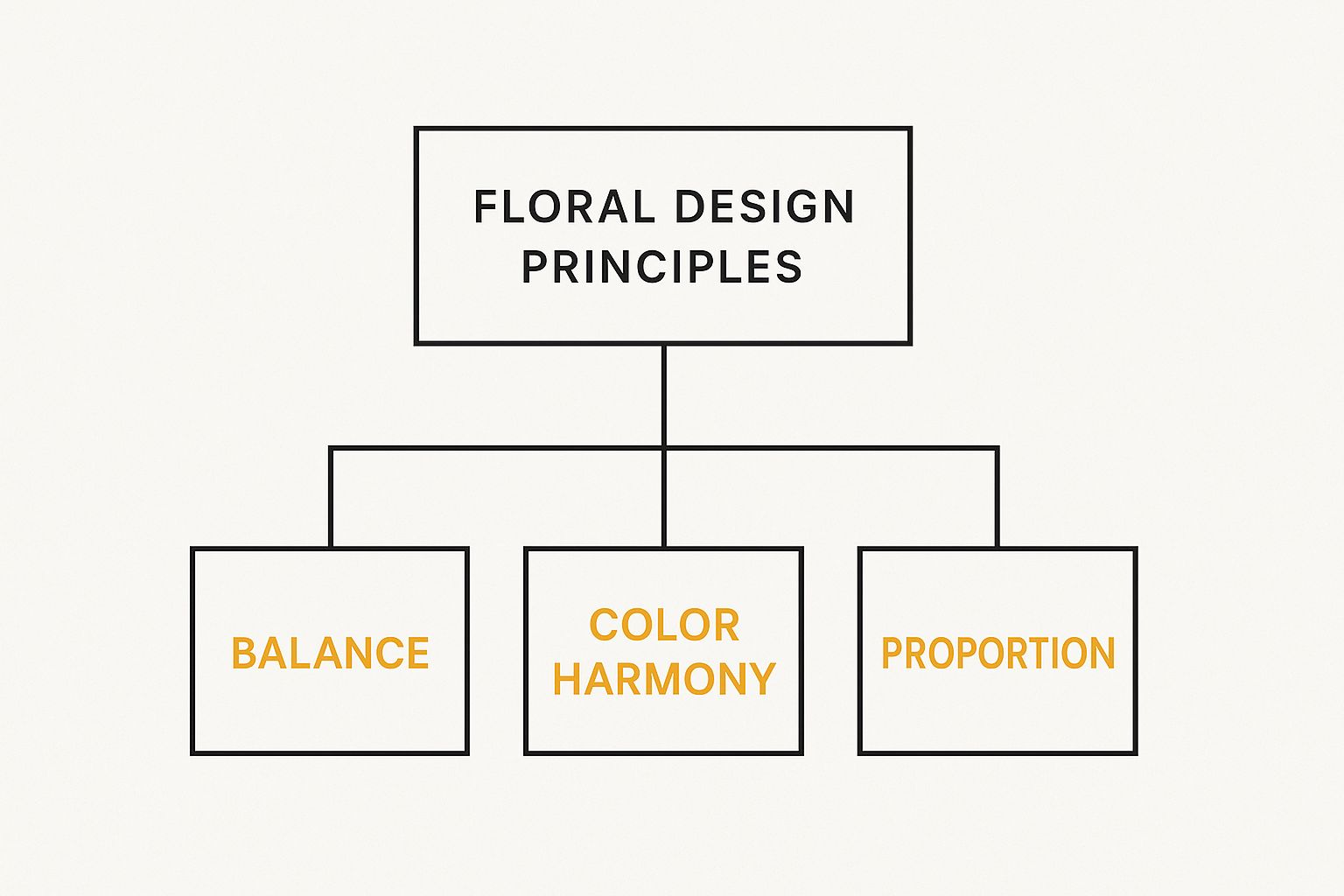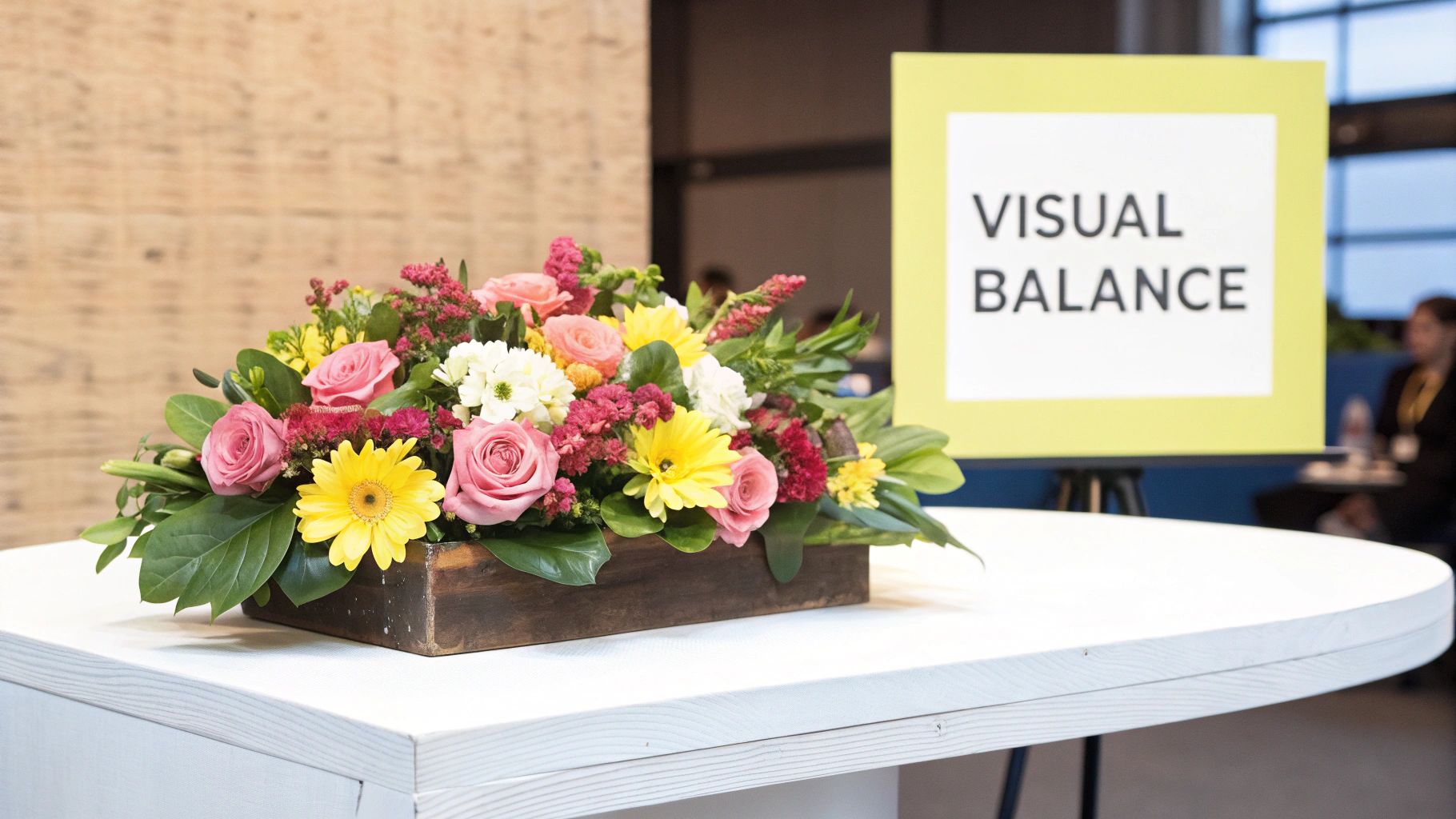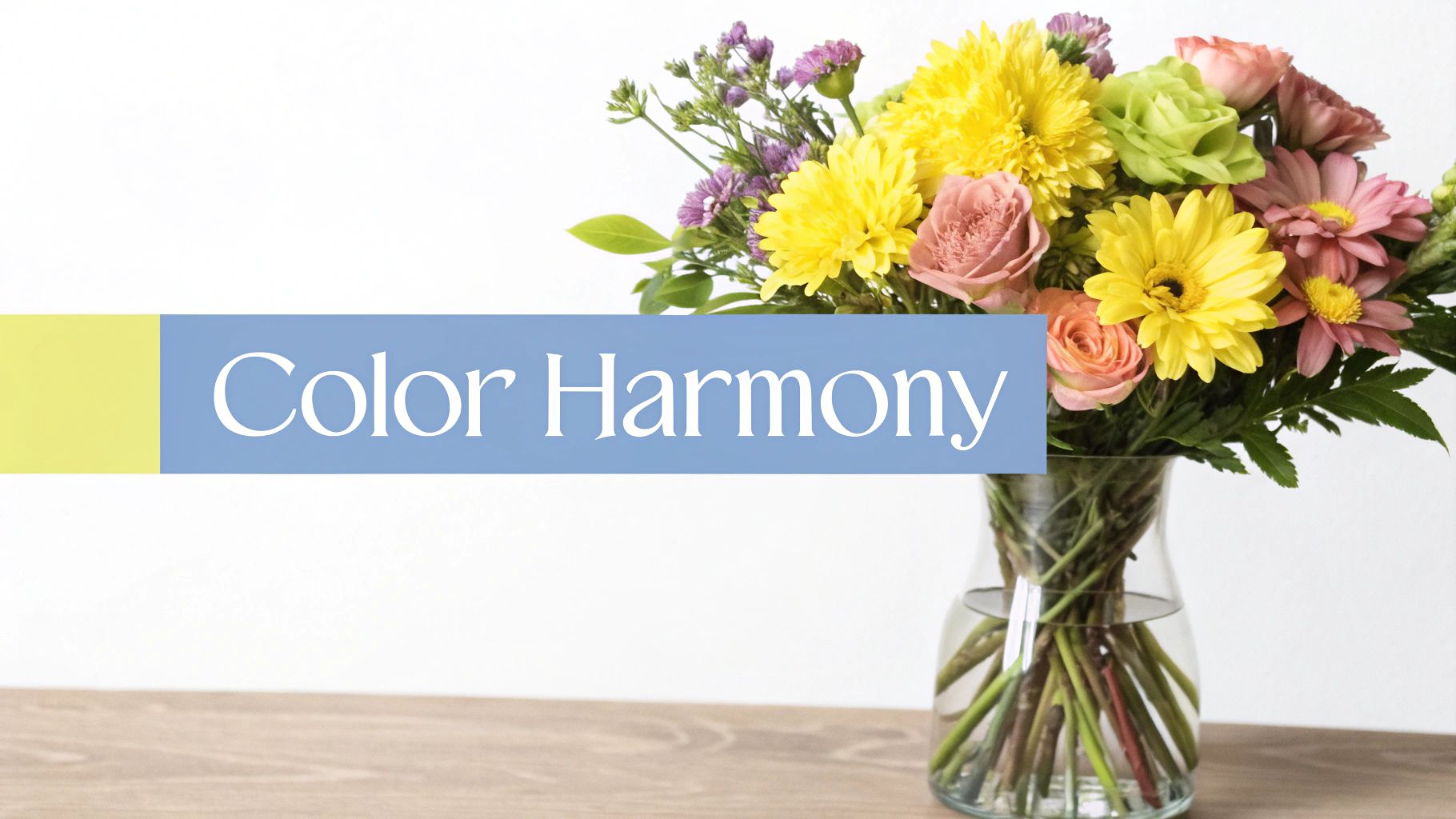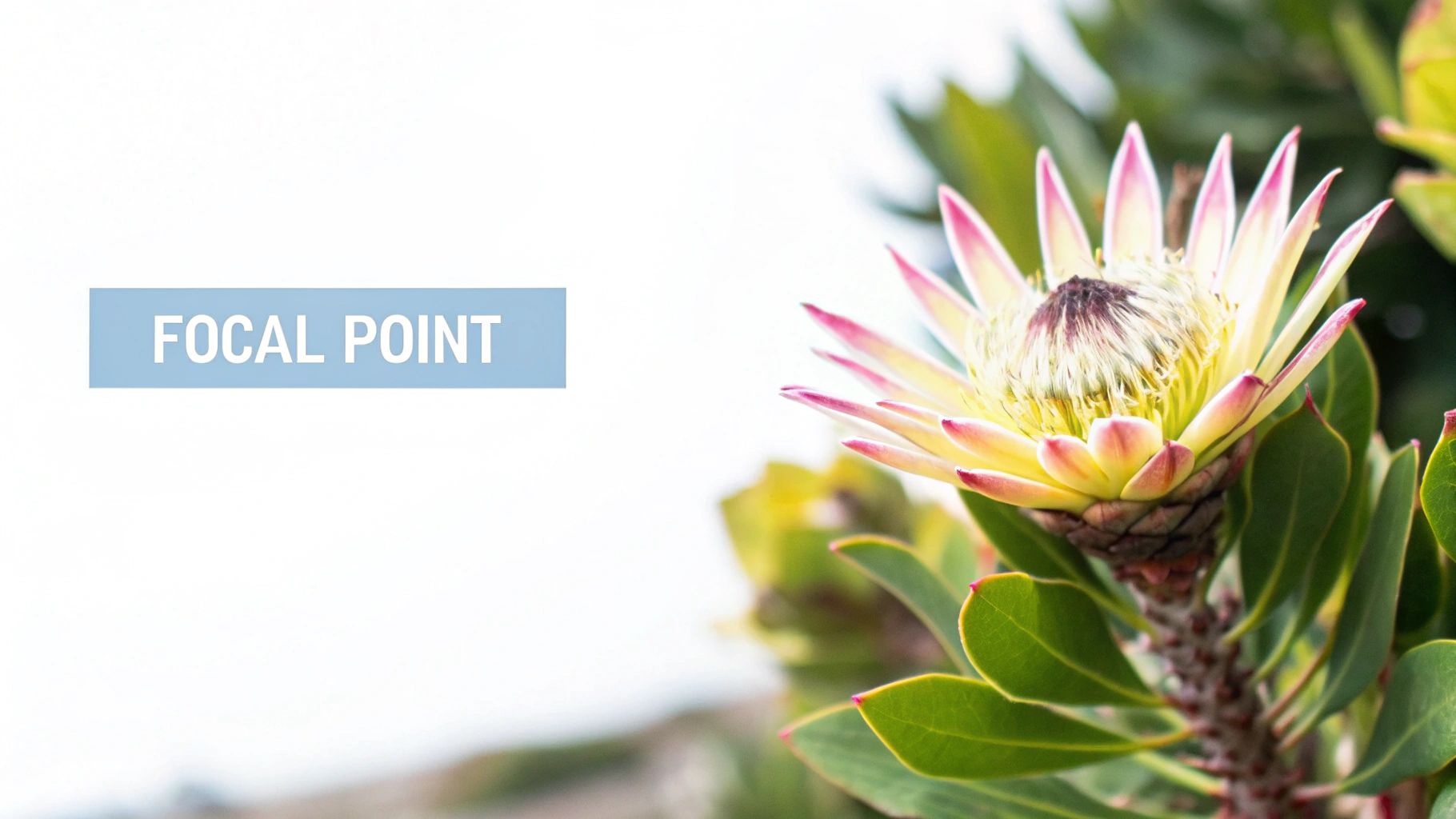
Mastering Floral Design Principles
Share
Have you ever looked at a floral arrangement and just thought, wow? What is it that elevates a simple bunch of flowers into something that stops you in your tracks?
The secret isn't magic, but it is an art. It comes down to a few core ideas known as the principles of floral design. Think of them less like strict, stuffy rules and more like a chef's trusted recipe for creating something visually delicious. They're the guides that help every single bloom, leaf, and stem work together in perfect harmony.
The Blueprint for a Breathtaking Bouquet
Just like a great song is more than just a collection of notes, a stunning arrangement is more than just a handful of flowers. A floral designer uses these principles to build a visual masterpiece, turning a simple vase of flowers into a thoughtful, intentional design.
Learning this "language of flowers" is what gives you the power to create arrangements that feel professional and tell a story. It’s not about holding back your creativity—it's about giving it direction so you can understand why some combinations just sing.
To help you get started, here's a quick look at the core principles we'll be diving into. Think of this as your cheat sheet for understanding what makes a design work.
Core Floral Design Principles at a Glance
| Principle | What It Achieves |
|---|---|
| Balance | Creates a sense of stability and visual weight. |
| Proportion & Scale | Ensures flowers and vase are appropriately sized for each other. |
| Rhythm | Guides the eye smoothly through the arrangement. |
| Focal Point | Establishes a clear center of interest. |
| Harmony | Makes all the elements look like they belong together. |
| Unity | Creates a cohesive, complete final look. |
Mastering these concepts is the first step toward creating truly memorable floral art.
Where the Magic Happens: The Core Concepts
Every successful design, from a simple bud vase to a grand centerpiece, rests on a few key pillars. This visual breaks down some of the most critical ideas we'll be exploring.

As you can see, foundational concepts like balance, color, and proportion are what hold everything else up. Getting a feel for these three is your ticket to creating more sophisticated and impactful work.
A Mix of Old and New
What's really fascinating is how modern floral design is a beautiful blend of Eastern and Western traditions. Around 1910, the Japanese art of Ikebana started to influence Western floristry, bringing with it a love for simplicity, negative space, and natural, flowing lines.
This shift was a game-changer. Today, roughly 40% of modern designs play with asymmetry, a direct nod to this Eastern influence that moved us away from the purely symmetrical, formal styles of the past.
A renaissance has indeed occurred, and floristry has become a more desirable endeavor. A new take on floristry has arisen. The commonality is that many in this “new wave” of florists have rejected the “rules” of floristry.
This new wave is all about challenging old norms, but here’s the key: knowing the classic principles is what gives you the confidence to break them with purpose. When you're ready to put these ideas into practice, our guide on how to make a beautiful bouquet is the perfect place to start.
Once you master these fundamentals, you’ll unlock endless creative possibilities and start developing a style that's all your own.
Finding Balance and Perfect Proportions

When you look at a floral arrangement and think, "Wow, that just works," you're usually reacting to two foundational principles: balance and proportion. These are the unsung heroes of floral design. They’re what make an arrangement feel grounded and visually satisfying, preventing even the most stunning flowers from looking like a chaotic mess.
Think of it like a seesaw on a playground. It’s not just about keeping the vase from literally tipping over—it’s about managing visual weight. Just as a small child can balance a much larger adult by sitting further from the center, a small, dark-colored flower can balance a large, light-colored one.
Every element in your bouquet has its own presence. Darker colors feel heavier, rough textures seem weightier than smooth ones, and large blooms obviously carry more visual heft. Achieving balance is all about distributing that weight so the whole piece feels stable and intentional, not lopsided.
The Two Faces of Balance
In our design studio, we work with two kinds of balance every day. Each one sets a completely different mood.
- Symmetrical Balance: This is your classic, formal look. If you drew an imaginary line down the middle, both sides would be a near-perfect mirror image. It feels orderly, traditional, and incredibly elegant, perfect for a grand centerpiece.
- Asymmetrical Balance: Here's where things get more modern and dynamic. The two sides aren't identical, but they still feel balanced. A big cluster of peonies on one side might be offset by a smaller group of ranunculus and a long, arching branch on the other. It creates movement and a more natural, "just-picked" vibe.
Knowing the difference is like having a secret weapon. You can intentionally choose whether you want the stately grace of a symmetrical design or the free-flowing energy of an asymmetrical one.
Getting the Proportions Just Right
Once your arrangement feels balanced, it's time to check the proportions. This is all about the size relationship between the flowers, the greenery, and the vase you put them in. When the proportions are on point, the entire piece sings in harmony.
"Proportion is the size relationship of one part of a floral design to another, or one portion to the whole. The size and relationship of the flowers to each other. The size of the flowers in comparison to the container that holds them."
A fantastic rule of thumb, passed down from one generation of florists to the next, is that your arrangement should be at least 1.5 times the height of its container. It’s a simple guideline that instantly prevents your design from looking squat or weirdly top-heavy. It's the perfect starting point.
This focus on proportion isn't new. During the Victorian era, arrangements were symbols of status, often packed tight with opulent blooms and trailing vines. It was during this period that floral design became a formal profession, with an estimated 70% of floral budgets going toward lavish events. We still see echoes of this today, as about 30% of modern arrangements feature lush foliage and cascading flowers—a clear nod to a time when grand proportions were everything. You can explore more about this rich history to see how these foundational ideas took shape.
Ultimately, good proportion comes down to what feels right to your eye. A giant hydrangea stuffed into a tiny bud vase looks awkward, just as a single petite daisy would be completely lost in an oversized urn. Choosing elements that have a pleasing size relationship is one of the most important steps to creating a bouquet that looks polished and truly professional.
Creating a Captivating Center of Interest
Every great story needs a main character, and every beautiful floral arrangement needs a star. This is one of the most exciting floral design principles to master because it’s where you, the designer, get to direct the show. This star performer is the focal point—that magnetic spot where your eyes land the moment you see the arrangement.
Without a clear focal point, an arrangement can feel a bit lost, like a conversation that wanders aimlessly. Your eyes search for a place to rest, but the design’s message gets muddled. But with a strong center of interest? The entire piece suddenly has purpose and impact. It gives every other flower a clear role to play: the supporting cast.
Now, this doesn’t mean you have to stick a single giant flower right in the middle. While that can work, it's just one trick in the book. A captivating focal point is really about creating a pop of visual contrast that stands out from everything else.
Beyond the Obvious Bloom
The real artistry here is moving beyond the expected. Think less about one "hero" flower and more about creating an area that demands attention. Luckily, you have a whole toolbox of techniques to make that happen.
Here are a few ways our designers at Bud Weismiller create a compelling focal point:
- A Splash of Unique Color: Imagine a single, fiery orange dahlia or a hot pink gerbera daisy tucked into a sea of soft, creamy pastels. That sudden shift in color is an irresistible magnet for the eye.
- An Intriguing Texture: Picture a cluster of fuzzy, velvety celosia or some spiky blue eryngium nestled among the smooth, classic petals of a rose. That textural surprise is enough to create a subtle but powerful focal area.
- Bold and Daring Foliage: Never, ever underestimate the power of a good leaf. A single large, dramatically patterned calathea leaf or a sculptural piece of monstera can anchor an entire design all on its own.
The secret is using an element that is distinctly different—in size, shape, texture, or color—from everything around it. This contrast is what creates that visual pull, giving your design a confident, intentional feel.
The focal point is the area of greatest visual impact; the center of interest where the eye is naturally drawn. It gives a design a sense of gravity and stability, providing a foundation from which the rest of the arrangement can flow.
Strategic Placement for Maximum Impact
Where you place your focal point completely changes the mood and flow of your design. It’s not just about what you use, but how you use it to tell the arrangement's story.
For instance, try tucking the focal point deep within the arrangement, letting it peek out from behind more delicate, airy flowers. This creates a wonderful sense of depth and mystery, inviting the viewer to look closer and discover the hidden beauty within. It’s a technique we love for lush, garden-style bouquets where you want to evoke a feeling of discovery.
On the other hand, placing the focal point right at the lip of the container can feel bold, modern, and even a little rebellious. This is a go-to for contemporary designs and works especially well in asymmetrical arrangements, where it can anchor one side of the composition with confidence.
Ultimately, mastering this principle is about making a deliberate choice. You are the director of this floral show, deciding which element gets the spotlight and how it will mesmerize your audience. By thoughtfully choosing and placing your center of interest, you stop just putting flowers in a vase and start truly designing.
Guiding the Eye with Rhythm and Movement

A truly magnetic floral arrangement does more than just sit there; it invites you on a visual journey. It has a flow, a sense of energy that pulls your gaze from one beautiful detail to the next. This captivating quality is one of the most important principles we use at Bud Weismiller: rhythm.
Think of rhythm as the melody of your arrangement. A great song has a beat and a flow that makes you want to move, and a great floral design uses rhythm to create a similar sense of visual movement. Without it, even the most gorgeous flowers can feel static and flat. With it, the entire piece comes alive.
The goal here is to create a clear, pleasing path for the eye to follow. It’s the visual choreography that guides someone through the piece, making sure they experience the whole composition. It’s how we create arrangements that feel dynamic and engaging from every angle.
Creating a Visual Beat
Rhythm isn’t a single action but a result created by several techniques working together. Just as a musician uses notes and pauses, a floral designer uses repetition, gradation, and line to build a visual cadence. These are the tools that make your arrangement sing.
-
Repetition: This is the simplest way to establish a beat. By repeating a specific color, flower type, or shape throughout the design, you create a sense of continuity. For example, placing three or four bright yellow ranunculus flowers at different heights and depths gives the eye familiar points to connect, creating a natural pathway.
-
Gradation: This technique involves a gradual transition from one state to another. You might arrange flowers by size, moving from small, tight buds at the edge of the arrangement to large, fully bloomed flowers near the focal point. This creates a powerful sense of flow and directs attention inward. A color gradation, like moving from pale pink to deep burgundy, has a similar effect.
-
Line: This is probably the most direct way to create movement. A long, gracefully curving branch of forsythia or a cascading piece of jasmine vine physically draws the eye along its path. We call this an actual line, but you can also create an implied line by strategically placing flowers so the brain automatically connects the dots.
Putting Rhythm into Practice
Let's imagine a garden-style arrangement in a low bowl. How would we use rhythm to make it feel vibrant and natural? We could start by establishing a strong line with a few arching branches of eucalyptus, creating a swooping "S" curve that flows from one side of the container to the other.
Next, we could use repetition by dotting pale blue delphinium florets along that curve, reinforcing the path for the eye. To add depth and direct focus, we can use gradation. We’ll place smaller, lighter-colored roses on the outer edges and transition to larger, deeper-hued peonies near the center.
Rhythm is the visual movement through a composition, usually achieved through repetition, gradation, or pattern. It's what connects one part of the design to another, creating a smooth, rhythmic visual journey.
This combination of techniques ensures the arrangement isn't just a collection of pretty flowers. It has a story and a direction. The eye starts on one side, follows the elegant curve of the branches and the pop of blue, and is gently guided toward the lush, dramatic center. This is the power of rhythm in action, transforming a static object into a dynamic work of art.
Achieving Harmony and Unity in Your Design

We've talked about creating balance, setting a focal point, and guiding the eye with rhythm. Now we've reached the grand finale—the part where all those individual choices come together to create a single, breathtaking statement. This is where harmony and unity steal the show.
While people often use these words interchangeably, they play distinct but deeply related roles in getting that finished, professional look. Think of it like putting together a killer outfit. Harmony is choosing a shirt, pants, and shoes that all share a similar vibe and look great together. Unity is how you actually wear and style those pieces to create a polished, complete look that feels totally intentional.
In floral design, this means every single element—from the tallest rose down to the smallest bit of greenery and even the vase itself—feels like it belongs. The final piece shouldn't look like a random collection of flowers; it should feel like one cohesive thought.
Harmony: The Art of Thoughtful Selection
Harmony is all about the shopping trip, the selection process. It's the art of gathering ingredients that have a pleasing relationship with each other. When your components are harmonious, they share a common character, creating a sense of peace and rightness. It just feels good to look at.
This all starts with the mood you want to create. For a soft, romantic arrangement, you might choose harmonious textures like the delicate petals of a garden rose, the airy feel of baby's breath, and the gentle curve of silver dollar eucalyptus. Want something bold and modern? The sleek, waxy texture of an anthurium next to the sharp lines of a tropical leaf creates a totally different, but equally harmonious, vibe.
To achieve harmony in your own arrangements, ask yourself:
- Do these elements share a mood? A rustic wildflower bouquet feels harmonious because the daisies, cornflowers, and grasses all evoke that same natural, meadow-like feeling.
- Is the character consistent? You can absolutely mix spiky, sculptural flowers with soft, rounded blooms for contrast, but they need to be balanced so they feel harmonious, not chaotic.
- How do the textures play together? Think about how the surface qualities interact. Velvety, smooth, glossy, and rough textures should complement each other to make the design richer.
Harmony is the foundation. It's the thoughtful groundwork that makes true unity possible.
Unity: The Final Masterpiece
If harmony is the curated collection of talented musicians, then unity is the beautiful symphony they perform together. Unity is the successful arrangement of all those harmonious parts into one seamless whole. It’s that feeling you get when you know nothing could be added or taken away without making the design worse.
Unity is the oneness of purpose, thought, style, and spirit. It’s the cohesive relationship of all parts that creates the feeling of a single, connected unit.
When a design has unity, all the other principles we’ve discussed—balance, proportion, rhythm, and focal point—are working together perfectly. The colors flow, the textures blend, and the lines guide your eye effortlessly through the whole piece. The entire arrangement simply feels complete.
This is often the biggest difference between a DIY project and a professional piece. If you're new to these concepts, understanding the difference between made-to-order vs. pre-made floral arrangements can really highlight how designers work to ensure perfect unity in every single creation.
A unified design hits you on an emotional level. It doesn't just look pretty; it feels right. It tells a clear visual story, whether that story is one of joyful celebration, quiet sympathy, or passionate romance. This is the ultimate goal—to create not just an arrangement, but an experience.
Bringing It All Together: A Principles Checklist
Feeling ready to put it all into practice? It can be a lot to remember. We've put together a simple checklist to help you review your own arrangements and see where you can make small tweaks for a big impact.
| Principle | Checklist Question | Quick Tip |
|---|---|---|
| Balance | Does the arrangement feel stable and visually weighted correctly? | Squint your eyes. Do any areas feel unusually "heavy" or "light"? |
| Proportion | Are the flowers, foliage, and vase appropriately sized for each other? | Follow the 1.5x rule: the arrangement should be about 1.5 times the height of the vase. |
| Focal Point | Is there one clear area that immediately draws your attention? | Use your largest, brightest, or most unique bloom as the star of the show. |
| Rhythm | Does your eye naturally move through the arrangement in a pleasing way? | Create pathways with lines of foliage or repeating colors and shapes. |
| Harmony | Do all the elements (colors, textures, shapes) feel like they belong together? | Stick to a consistent mood, whether it's rustic, modern, romantic, or playful. |
| Unity | Does the entire piece feel like a single, complete unit? | Step back and ask: "Does anything feel out of place or could I remove anything?" |
By keeping these core principles in mind, you move from simply putting flowers in a vase to truly designing a piece of living art. It's a journey, but every arrangement you create is a step toward mastering that beautiful final symphony.
From Theory to Tangible Beauty
You’ve got the theory down—all those ideas that give floral arrangements their incredible appeal. Now for the fun part: turning that knowledge into something real, something you can touch and admire. This is your chance to pick up some stems and bring your vision to life, armed with a fresh understanding of what makes a design work.
Think of these principles as trusted guides, not rigid rules. They’re the very same concepts our designers at Bud Weismiller use every single day to create arrangements that feel just right—balanced, rhythmic, and perfectly whole. You now have the same creative blueprint we do.
The secret to getting started? Pick a project that excites you, not one that feels like a huge, overwhelming task. Don’t pressure yourself to create a massive centerpiece on your first go. Instead, just give yourself permission to play.
Your First Creative Steps
Think of your first few arrangements as practice sketches in a notebook. The real goal is just to get a feel for how different flowers and greens work together, and to see the design principles in action, right in your own hands. Starting small is the key. It lets you focus on nailing one or two concepts at a time.
Here are a few manageable ideas to get you started:
- A Simple Monochromatic Bouquet: Pick a color you absolutely love and gather flowers in different shades and textures of that same hue. This is a brilliant way to practice creating harmony and unity without juggling a complex color palette.
- A Small Asymmetrical Design: Grab a simple bud vase and just a few stems. Try creating an asymmetrical balance with one larger, showy bloom on one side and a delicate, arching piece of greenery on the other. It's a fantastic exercise in rhythm and line.
- A Focal Point Study: Choose one standout flower to be your "star." Then, build a small arrangement around it using more subtle, supporting blooms. This sharpens your eye for creating a clear, captivating center of interest.
The most important thing is simply to begin. Floral design is a hands-on art. It grows with practice and a bit of joyful experimentation. There are no mistakes here, only learning opportunities that will eventually shape your own unique style.
As Picasso famously said, "Learn the rules like a pro, so you can break them like an artist." By understanding the fundamentals of balance, proportion, and rhythm, you've earned the creative license to make them your own.
Your floral journey is just beginning. Remember to take good care of your flowers to get the most out of your practice. For some pro tips on making every creation last, check out our guide on The Hydration Handbook: Keeping Your Flowers Fresh and Fabulous.
So go ahead—gather some of your favorite blooms, find a quiet corner, and let your creativity flow. It’s time to turn what you’ve learned into something beautiful.
Got Questions? We've Got Answers.
As you start playing with flowers and getting a feel for these design principles, questions are bound to bubble up. That’s a good thing! It means you’re thinking like a designer.
We get these questions all the time at our Las Vegas studio, so we’ve put together a few of the most common ones. Think of this as a quick chat with one of our lead floral artists—clearing up the confusion so you can get back to creating.
Which Floral Design Principle Is the Most Important?
This is a great one, but it’s a little like asking which musician is the most important in a band. They all need each other to make music! But if we had to put one at the top of the pyramid, it would be balance.
Why? Because without it, an arrangement can look like it's about to topple over, or it just feels visually jarring. No matter how stunning the individual flowers are, a lack of balance will sink the whole design. It’s the skeleton that holds everything else together. Nail that feeling of stability, and adding rhythm or a focal point becomes a whole lot easier.
How Do I Fix an Arrangement That Just Feels "Off"?
We've all been there. You step back, look at your creation, and something is just… not right. Don't panic! Take a five-minute break, grab a drink of water, and come back with fresh eyes. Nine times out of ten, the culprit is either proportion or unity.
- Check your proportions: Is your arrangement roughly 1.5 times the height or width of your vase? Do the big, showy flowers feel like they're overwhelming a delicate container? Sometimes, the fix is as simple as swapping out the vase.
- Look for unity: Ask yourself, "Does everything in here feel like it belongs to the same family?" Maybe that one spiky thistle looks out of place among soft, romantic peonies. Pulling out that single stem that doesn’t match the overall vibe can magically bring the whole piece into harmony.
The number one mistake we see beginners make is trying to use too many flowers. Don't be afraid of empty space! Negative space lets each flower breathe and show off its unique beauty, making the entire design stronger.
Can I Break the Rules of Floral Design?
Absolutely! In fact, you should. The most breathtaking, artistic arrangements often come from designers who know the rules so well that they can break them on purpose.
The trick is to understand why a rule exists before you shatter it. You have to know how to create harmony before you can disrupt it for dramatic effect. For example, a deliberately off-balance arrangement can make a huge artistic statement, but it only works when it’s an intentional choice, not an accident. Master the basics first. That’s when your personal style really starts to shine.
Ready to skip the learning curve and have a masterpiece show up at your door? The floral artists at Bud Weismiller Flowers live and breathe these principles every day, hand-crafting stunning arrangements for every Las Vegas occasion.
Explore our collections and let us create something beautiful for you.


 https://budweismiller.com
https://budweismiller.com